In professional networking, LinkedIn is like a bustling town square where connections are made and opportunities grow. But how do you start a conversation that’s not just polite but interesting, too? You can enter the field of cold messaging on LinkedIn, where a well-worded message can turn a simple connection into a potential collaboration, mentorship, or job opportunity.
In this article, we’ll explore the basics of reaching out professionally and making your messages stand out. So, let’s dive into the simple art of messaging, where a friendly message can decrease the formality and open up new possibilities.
Before discovering how to cold message on LinkedIn, let’s start with a definition.
What is cold messaging on LinkedIn?
In fact, a cold email is the earliest communication, the first electronic message you send to potential customers or partners. When writing a cold message, the critical task is to get the recipient interested enough to open it.
On the other hand, cold messaging on LinkedIn is the proactive act of sending direct messages to individuals not part of your existing network. This LinkedIn cold outreach tactic is employed by professionals seeking new business prospects, job opportunities, collaborations, or simply aiming to broaden their professional circle. It is a direct avenue for initiating conversations with potential clients, partners, or industry counterparts.
Between 2024 and 2028, the projected growth indicates a consistent rise in the global count of LinkedIn users. According to the Statista report, this period is expected to witness a cumulative increase of 171.9 million users, reflecting a notable surge of 22.3 percent. Following six consecutive years of growth, the LinkedIn user base is anticipated to achieve a landmark peak of 942.84 million users in 2028. So, cold messaging allows users to tap into this extensive network, exceeding geographical boundaries for meaningful connections.
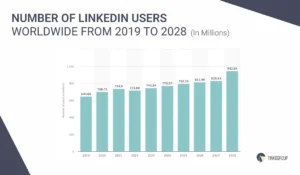
Crucial benefits of LinkedIn cold messages for businesses
Regarding the ever-evolving digital marketing and B2B (business-to-business) interactions, LinkedIn is a powerful tool for professionals seeking to expand their network, generate leads, and drive business growth. Among its various features, using cold messages on LinkedIn offers many advantages for businesses.
So, let’s check the critical benefits of integrating LinkedIn cold messages into your business strategy.
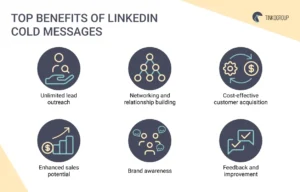
Unlimited lead outreach
LinkedIn cold messages empower businesses to engage in unlimited lead outreach, breaking down geographical barriers and providing access to a global pool of potential clients. This unparalleled reach ensures companies can connect with decision-makers, influencers, and key stakeholders across various industries, expanding their prospect list beyond traditional limitations.
Networking and relationship building
Beyond the initial outreach, LinkedIn cold messages provide a platform for meaningful networking and relationship building. Building connections through personalized messages allows businesses to establish connections, understand the needs of their prospects, and foster long-term relationships. LinkedIn’s interactive nature facilitates ongoing communication, enabling businesses to stay top-of-mind and strengthen ties with their audience.
Cost-effective customer acquisition
Compared to traditional marketing channels, LinkedIn cold messages offer a cost-effective way to acquire customers. Businesses can reach a specific audience with targeted messaging, minimizing wasteful spending on irrelevant leads. The direct nature of cold messages also reduces the need for intermediaries, resulting in a streamlined and cost-efficient customer acquisition process.
Enhanced sales potential
LinkedIn cold messages provide a direct channel for businesses to showcase their products or services to a highly targeted audience. By tailoring messages to address prospects’ pain points and interests, companies can effectively demonstrate the value they bring. This targeted approach enhances the potential for successful sales conversions, allowing businesses to close deals more efficiently and with a higher success rate.
Brand awareness
Consistent and strategic use of LinkedIn cold messages boosts brand awareness. By regularly engaging with the target audience, businesses can position themselves as industry leaders, thought influencers, and reliable partners. LinkedIn’s interactive nature fosters a two-way communication channel, enabling businesses to share their expertise, showcase achievements, and build a strong brand presence within their niche.
Feedback and improvement
LinkedIn cold messages also serve as a valuable feedback loop for businesses. Engaging with prospects and customers through direct messages allows companies to gather insights, understand pain points, and identify areas for improvement. This real-time feedback can be instrumental in refining products, services, and overall business strategies. As a result, this contributes to continuous growth and adaptation in a dynamic business landscape.
Thus, the strategic use of LinkedIn cold messages positions businesses at the forefront of digital engagement, driving sustained growth and success.
Main types of cold messages on LinkedIn
It is well-known that cold messaging on LinkedIn has become an essential instrument for generating connections and exploring new opportunities. If you opt for a personalized touch or a more streamlined template approach, each method has advantages and considerations. Let’s discover them together!
Personalized LinkedIn cold messages
These messages are created to resonate with the specific individual you are reaching out to. Rather than employing a one-size-fits-all strategy, personalized messages consider the recipient’s profile, experiences, and interests.
By referencing specific details from their profile, such as recent achievements, shared interests, or mutual connections, you demonstrate a genuine interest in them as an individual. This approach captures attention and sets the foundation for a more meaningful and authentic connection.
However, the key to success lies in striking a balance. Over-personalization can come across as insincere or pushy, so it’s crucial to tailor your message thoughtfully without shifting into overly familiar territory.
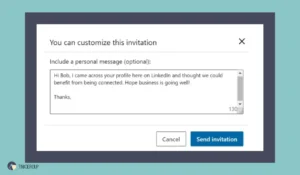
Non-personalized (template) cold messages
On the other hand, non-personalized cold messages are more systematic and efficient. They follow a template that can be adapted for various recipients with minimal changes. While this method may lack the custom charm of personalized messages, it excels in scalability and time efficiency.
Template messages are beneficial when reaching out to a broader audience, such as during job searches or when prospecting clients. They enable you to maintain a consistent outreach strategy without spending excessive time on each message.
However, the challenge lies in avoiding a generic tone that leaves recipients feeling like another name on a list. Customizing templates with at least some degree of personalization (such as acknowledging the recipient’s industry or expressing admiration for their work) can significantly enhance the effectiveness of this approach.
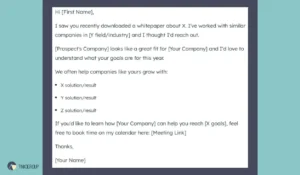
In conclusion, the choice between personalized and non-personalized cold messages ultimately depends on your specific goals and the nature of your outreach. Personalization builds rapport and fosters genuine connections, while templates offer efficiency in mass outreach. Finding the right balance for your unique situation will undoubtedly enhance your effectiveness in guiding the ever-evolving landscape of LinkedIn networking.
Best practices on how to cold message on LinkedIn
There is a simple fact: networking has become a cornerstone for career success, and LinkedIn is the digital epicenter of professional connections. Cold messaging on LinkedIn can be a powerful strategy if executed thoughtfully. So, we want to take you through the essential steps to make compelling LinkedIn cold messages that resonate with your target audience and open doors to new opportunities.
1. Optimize your LinkedIn profile for credibility
Before diving into cold messaging, we recommend following this guide:
- Ensure your LinkedIn profile is a testament to your professionalism and expertise.
- Use a high-quality profile picture, create a compelling headline, and write a concise yet impactful summary highlighting your skills and accomplishments.
- Remember to showcase your experience, education, and relevant certifications.
As a result, an optimized profile increases your credibility and encourages potential connections to take your LinkedIn cold outreach seriously.
2. Identify your target audience – create a buyer persona
Understanding your target audience is fundamental to composing personalized and effective cold messages. Create a buyer persona by defining the characteristics of your ideal connection.
Consider industry, job title, location, and shared professional challenges. This detailed profile will guide you when tailoring your messages to resonate with the specific needs and interests of your intended audience.
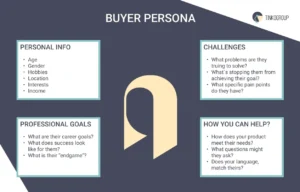
There are crucial steps to building a buyer persona:
- Consider your business idea;
- Analyze existing data;
- Collect additional data with some additional sources (Quora.com, Google Analytics, Facebook Analytics/ Twitter Analytics, and more);
- Ask your existing buyers;
- Describe your favorite customer.
3. Research and personalize your message approach
In most cases, generic messages rarely capture attention. Before reaching out, research your potential connections to gather insights into their professional background, achievements, and interests.
Mention specific details in your message to demonstrate that you’ve invested time understanding them. Personalization increases the chances of a positive response and sets you apart from others who may be sending generic messages.
4. Be clear and concise
In the fast-paced world of professional networking, brevity is critical. Make messages that are clear, concise, and easy to read.
It is critical to start with a brief introduction, mention the purpose of your message, and explain how connecting could be mutually beneficial. Moreover, avoid unnecessary jargon and focus on straightforwardly conveying your message.
5. Showcase your value proposition
Highlighting your value is crucial when cold messaging. Clearly state what sets you apart and how your skills, experience, or knowledge can benefit the recipient.
Be specific about the value you bring to the table and why connecting with you is worth their time. A compelling value proposition increases the likelihood of a positive response and fosters a foundation for a meaningful professional relationship.
6. Search with targeted job titles for your audience
You can use LinkedIn’s advanced search features to identify individuals matching your target audience criteria. Narrow your search using specific job titles, industry keywords, and location filters.
This targeted approach ensures that your LinkedIn cold messages reach professionals who are most likely interested in your profile and what you offer.
7. Use a professional and respectful tone
Maintain a professional and respectful tone throughout your cold messages. Address the recipient by name, express genuine interest in their profile, and use polite language. Avoid sounding overly familiar or pushy, as this can create a negative impression.
It is essential to remember that building professional relationships requires a foundation of mutual respect and courtesy.
8. Employ clear call-to-actions (CTAs)
Guide your potential connections on the next steps by incorporating clear and compelling call-to-actions in your messages. Whether scheduling a call, exploring possible collaboration, or sharing insights, make it easy for the recipient to understand how they can benefit from connecting with you. A well-crafted CTA enhances the chances of receiving a positive response and moving the conversation forward.
Let’s check some common CTA ideas:
- Keep me informed.
- Talk to us.
- Give us a call.
- Find out more!
- Learn more information.
- Click here and save!
- Sign up for our newsletter.
- Take action!
- Become a member!
- Start today!
Below is a vivid example of LinkedIn CTA.
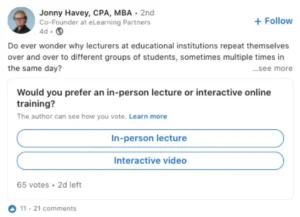
9. Follow up appropriately
Not every Linkedin cold message will result in an immediate response, and that’s okay. After sending your initial message, follow up promptly and carefully.
So, send a polite reminder expressing your continued interest and willingness to connect. However, avoid being overly persistent; it’s crucial to respect the recipient’s time and decisions.
10. Test your results
Continuously analyze and refine your cold messaging strategy by testing different approaches. For example, you can experiment with variations in your messages, CTAs, and outreach timing.
Also, you can pay attention to metrics such as response rates and connection acceptance rates. Use these insights to adapt and optimize your approach, ensuring that your cold messaging efforts yield the best possible results.
In conclusion, cold messaging on LinkedIn can be valuable for expanding your professional network and uncovering new opportunities. By optimizing your LinkedIn profile, identifying your target audience, personalizing your messages, and following the best practices, you’ll be well-positioned to make meaningful connections and advance your career. It is essential to understand that building relationships takes time and effort, so approach cold messaging with patience, persistence, and professionalism.
How to handle rejections and negative responses to your cold LinkedIn message
Sending cold messages on LinkedIn can be an effective way to network and explore new opportunities. However, not every interaction will deliver the desired response. Receiving a rejection or a negative response can be frustrating, but it’s crucial to handle these situations with resilience and professionalism.
Here is a short guide on how to guide such scenarios while maintaining a positive and constructive mindset.
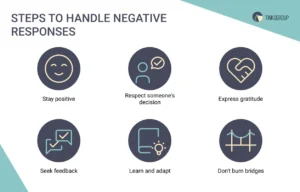
- Stay positive
Assume a positive mood and recognize that rejections are a natural part of professional life. Understand that people may decline your message for various reasons unrelated to your skills or worth. Use each rejection as a stepping stone toward your next opportunity, and remember that perseverance is vital in networking.
- Respect someone’s decision
Care that everyone has priorities, schedules, and reasons for not engaging in a conversation. Avoid taking rejections personally and resist the temptation to push for an explanation. Professionalism involves acknowledging and gracefully accepting the decisions of others.
- Express gratitude
Respond to rejections with gratitude for the recipient’s time and consideration. A simple, respectful message can leave a positive impression and open the door for future interactions. Expressing gratitude shows that you value their time and professionalism, regardless of the outcome.
- Seek feedback
If appropriate, politely ask for feedback on your approach. Understand that not everyone may have the time to provide detailed insights, but seeking constructive criticism can be valuable for self-improvement. Use any feedback received to refine your approach in future networking initiatives.
- Learn and adapt
Treat each rejection as a learning opportunity. Analyze your approach, messaging, and overall strategy. Identify potential areas for improvement and make necessary adjustments. Continuous learning and adaptation are vital for success in networking, and each rejection can contribute to your growth as a professional.
- Don’t burn bridges
Maintain professional behavior even in the face of rejection. Resist the desire to respond negatively or burn bridges. The professional landscape is interconnected, and maintaining a positive reputation is crucial. You never know when paths may cross again, and leaving a lasting positive impression is essential for future opportunities.
So, handling rejections gracefully and positively is integral to building a successful professional network. Adopt rejection as a natural part of the journey, learn from each experience, and remember that maintaining professionalism and respect is critical to long-term success in your networking efforts on platforms like LinkedIn.
Essential tips to avoid mistakes when cold messaging on LinkedIn
Navigating cold messaging on LinkedIn requires mastery and attention to detail to avoid common pitfalls. Here are our five expert tips to elevate your cold messaging and make lasting impressions:
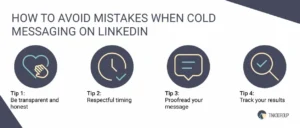
Tip 1: Be transparent and honest
Trust is the foundation of any meaningful connection, and honesty is the cornerstone. When reaching out to someone on LinkedIn, be transparent about your intentions. Communicate clearly why you want to connect and how the relationship could be mutually beneficial. Authenticity establishes credibility and sets the stage for a genuine and lasting professional rapport.
Tip 2: Respectful timing
In general, timing is everything, even in the digital realm. Before firing off a message, consider the recipient’s time zone and schedule. Respectful timing demonstrates your consideration for their work-life balance. Use LinkedIn’s “active status” feature to gauge when your connection is online, increasing the likelihood of a timely response. Remember, striking the right balance between promptness and courtesy can significantly impact the success of your LinkedIn cold outreach.
Tip 3: Proofread your message
First impressions matter, and a well-crafted message can make all the difference. Before hitting send, take a moment to proofread your message. Typos and grammatical errors can undermine your professionalism and credibility. A polished message showcases your attention to detail and reflects positively on your commitment to effective communication.
Tip 4: Track your results
Tracking your results is essential to refining and optimizing your cold messaging strategy. Use LinkedIn’s analytics to monitor open, response, and click-through rates. This data provides valuable insights into the effectiveness of your messages and helps you tailor your approach for better outcomes. Continuously analyzing and adapting your strategy based on these metrics will ensure that your cold messaging efforts yield positive results over time.
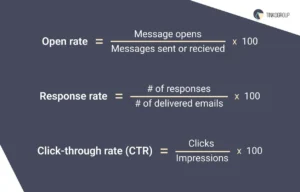
10 vivid LinkedIn cold message cases
Creating effective cold messages involves maximizing personalization and tailoring them to different industries. It is essential to recognize that a message successful in one context might not yield the same results in another. Nonetheless, consider each LinkedIn cold message template as a recommended starting point to initiate connections and engage with your audience.
Example #1
Hi [Name],
I hope this finds you at the right time.
I was thinking, and I know of a perfect way that your company could increase its sales by [Amount]. I’d love to explain this to you if you’re interested in giving me just 10 minutes of your time.
Hope to hear back soon.
Thanks, [Your_Name]
Example #2
Hi [Name],
I recently came across [Article] and thought you might find it interesting. [Write a line or two about the article.]
I also wanted to let you know that [Your_Company] offers a similar [Solution] to help [Target_Audience]. Would you like to hear some of the details? It will only take a moment, and I will understand if it’s not a good fit for you.
Thanks, [Your_Name]
Example #3
Hi [Name],
Thanks for connecting with me earlier this week. While I was researching [Company], I happened to recognize one of the key problems that used to affect us, [Key Relatable Problem]. Fortunately, we found a solution, which was [Solution].
If you’re free to give me a few minutes I can explain how my company, [Your_Company], can help you quickly resolve it.
Thanks!
[Your_Name]
Example #4
Hi [Name],
Thanks for connecting with me. I was exploring your platform and found that it had [Problem] which my company, [Your_Company], specially helps out with. I don’t want to pressure you into anything, but if you would like to hear about our solution, then it will only take 10 minutes of your time.
Thank you!
[Your_Name]
Example #5
Hi [Name],
What if I told you that I could help [Company] increase their [Metric] by [Amount]?
Would you believe me? And would you want to learn a little more?
Because my company, [Your_Company], has helped many other businesses, just like yours, do that very thing.
You can read some of our client reviews here if you’re interested: [link]
Hope to chat with you soon.
[Your_Name]
Example #6
Hi [Name],
Thanks for connecting with me. I came across your profile and after briefly researching, found you were using one of our competitor’s platforms for [Service].
If you don’t mind me asking, how have your results with them been till now?
Some of our clients used them in the past, and faced [Problem]. Have you ever experienced the same while using it?
If you’re interested in learning a little more about our [Service], I can show you how much better our [Product] is in as little as 15 minutes.
Thanks again.
[Your_Name]
Example #7
Hi [Name],
I noticed the social media post [Company] made today, and [some thoughts on the post].
Related to that, some clients we serve experienced [results relatable to the post]. With our help, they have [positive effects of service].
If you’re interested in sitting down with me for 10 or 15 minutes, we could discuss how you could experience the same [positive effects of service].
Hope to hear from you.
[Your_Name]
Example #8
Hi [Name],
Imagine if you didn’t have to manage [Daily_Task] every single day, what would your day be like? You would probably have a lot more time to focus on other important tasks!
With [Your_Service], you can do just that. We help business owners like yourself focus on what’s most important.
Let’s have a quick chat if this interests you.
Thanks for connecting,
[Your_Name]
Example #9
Hi [Name],
I know we haven’t spoken in a while, but my company [Your_Company] is having an incredible promotion of [Promotion]. Being in the [X Industry], I thought you might find a use in [Your_Service].
I just thought I’d let you know, and if you have any questions, please don’t hesitate to ask.
Thanks!
[Your_Name]
Example #10
Hi [Name],
Thanks for connecting with me last week. I don’t want to take up any unnecessary time, but I noticed that your company, [Company], doesn’t have a [Missing_Value], and my company specializes in providing that very thing.
You don’t have to take my word for it though, as we have many client testimonials describing our services in detail, you can check them out at [link].
Have a great rest of your day, and I’m open to any and all questions you may have.
[Your_Name]
Advanced tools for effective cold emailing on LinkedIn
Creating effective cold emails on LinkedIn requires a strategic approach, and the right tools can significantly enhance your outreach efforts. Let’s explore how these tools can empower your cold emailing strategy on LinkedIn.
PhantomBuster
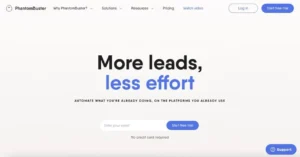
This universal tool automates various tasks, including extracting LinkedIn profiles and sending connection requests. With PhantomBuster, you can streamline your prospecting process by efficiently collecting data and initiating connections with potential leads.
Dux-Soup
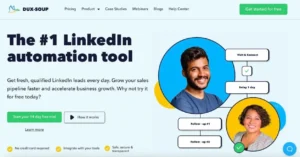
As a LinkedIn automation tool, Dux-Soup automates profile visits and personalized messages, enabling you to engage with prospects at scale. By using its features, you can nurture relationships and generate leads more effectively while saving time on manual LinkedIn cold outreach tasks.
Expandi
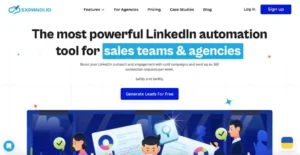
It offers advanced LinkedIn automation capabilities, allowing you to personalize messages, schedule follow-ups, and track campaign performance. With its intuitive interface and robust features, Expandi empowers you to create targeted outreach campaigns that yield better results.
Snov.io
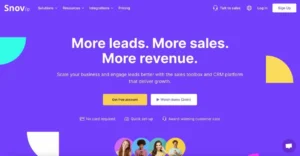
This email marketing and outreach platform provides LinkedIn email finder capabilities, helping you discover verified email addresses of your LinkedIn connections. By integrating Snov.io into your cold emailing strategy, you can ensure that your messages reach the right people and maximize your response rates.
Lempod
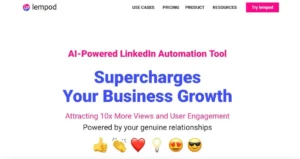
It is a LinkedIn engagement pod that enables you to boost the visibility of your content and increase your reach on the platform. By joining relevant pods within your niche, you can upgrade your LinkedIn posts, enhance your credibility, and attract the attention of potential prospects.
Meet Alfred
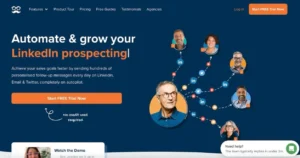
It offers LinkedIn automation features, allowing you to automate connection requests, profile visits, and messaging sequences. With its sophisticated targeting options and personalized messaging capabilities, Meet Alfred helps you engage with prospects meaningfully and drive conversions.
Zopto
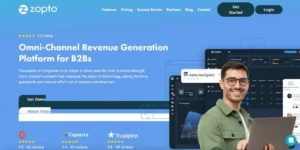
This LinkedIn automation tool is designed to streamline lead generation and outreach efforts. By employing its advanced targeting filters and automation features, you can identify and connect with your ideal prospects on LinkedIn, leading to more fruitful conversations and business opportunities.
Octopus CRM

This tool integrates with LinkedIn to simplify lead generation, prospecting, and relationship management. With its CRM (customer relationship management) functionalities and LinkedIn automation tools, you can organize your contacts, track interactions, and nurture leads more effectively, ultimately driving business growth.
So, using these tools, you can optimize your cold emailing strategy on LinkedIn and achieve better results. If you want to expand your network, generate leads, or nurture relationships, investing in the right tools can make all the difference in your LinkedIn cold outreach efforts.
Conclusion
Successful cold messaging is about making real connections, not big gestures. In the digital world, where profiles are more common than handshakes, a well-written message is very important.
If you’re reaching out for career advice, collaboration, or expanding your professional network, focus on being genuine. Make your messages clear, short, and respectful. Good professional relationships start and grow through thoughtful interactions.
Think of each LinkedIn cold message as an introduction to a potential ally or mentor. It’s vital to break the ice with a friendly tone, and you’ll see that authentic connections can overcome digital barriers.
At Tinkogroup, we specialize in revolutionizing data processing solutions to elevate your business. With our email list building, you can unlock actionable insights, streamline operations, and make data-driven decisions.
Ready to take your networking to the next level? Contact us today to discover how personalized data processing can be the key to unlocking unparalleled success.
FAQ
How to cold message on LinkedIn?
To do this effectively, follow these steps: optimize your LinkedIn profile, identify your target audience, personalize your messages, craft a captivating subject line, be concise and direct, include a call-to-action (CTA), use LinkedIn Premium Features, build genuine relationships, and more.
How to send a cold message on LinkedIn?
Sending a cold message on LinkedIn requires a thoughtful and strategic approach. Here is a step-by-step guide: research your recipient, start with a friendly greeting, clearly state your purpose, demonstrate value, respect privacy and professionalism, monitor and analyze results, and more.

